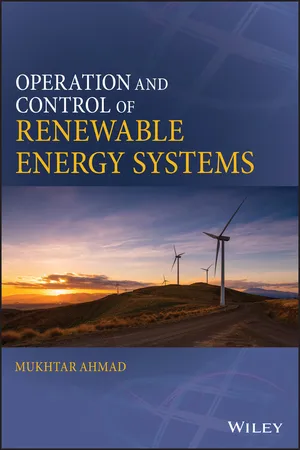
- English
- ePUB (mobile friendly)
- Available on iOS & Android
Operation and Control of Renewable Energy Systems
About This Book
A comprehensive reference to renewable energy technologies with a focus on power generation and integration into power systems
This book addresses the generation of energy (primarily electrical) through various renewable sources. It discusses solar and wind power—two major resources that are now in use in small as well as large-scale power production—and their requirements for effectively using advanced control techniques.In addition, the book looks at theintegration of renewable energy in the power grid and its ability to work in a micro grid.
Operation and Control of Renewable Energy Systems describes the numerous types of renewable energy sources available and the basic principles involving energy conversion, including the theory of fluid mechanics and the laws of thermodynamics. Chapter coverage includes the theory of power electronics and various electric power generators, grid scale energy storage systems, photovoltaic power generation, solar thermal energy conversion technology, horizontal and vertical wind turbines for power generation, and more.
- Covers integration into power systems with an emphasis on microgrids
- Introduces a wide range of subjects related to renewable energy systems, including energy storage, microgrids, and battery technologies
- Includes tutorial materials such as up-to-date references for wind energy, grid connection, and power electronics—plus worked examples and solutions
Operation and Control of Renewable Energy Systems is the perfect introduction to renewable energy technologies for undergraduate and graduate students and can also be very useful to practicing engineers.
Frequently asked questions
Information
Chapter 1
Sources of Energy and Technologies
1.1 Energy Uses in Different Countries

- Motors (approximately 40–45%)
- Lighting (15%)
- Home appliances (15%)


1.2 Energy Sources
1.2.1 Non-Renewable Energy Resources
Table of contents
- Cover
- Title Page
- Copyright
- Table of Contents
- Preface
- Chapter 1: Sources of Energy and Technologies
- Chapter 2: Power Electronic Converters
- Chapter 3: Renewable Energy Generator Technology
- Chapter 4: Grid-Scale Energy Storage
- Chapter 5: Solar Energy Systems
- Chapter 6: Photovoltaic Systems
- Chapter 7: Wind Energy
- Chapter 8: Biomass Energy Systems
- Chapter 9: Geothermal Energy
- Chapter 10: Ocean Energy
- Chapter 11: Fuel Cells
- Chapter 12: Small Hydropower Plant
- Chapter 13: Control of Grid-Connected Photovoltaic and Wind Energy Systems
- Chapter 14: Renewable Energy Sources Integration in Microgrid
- Index
- End User License Agreement